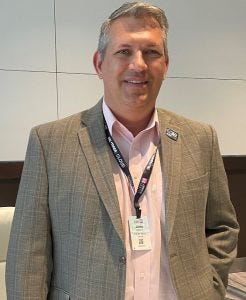Ingram Micro Talks AWS Partnership Success, CloudBlue, MSPs, Cybersecurity, MoreIngram Micro Talks AWS Partnership Success, CloudBlue, MSPs, Cybersecurity, More
“AWS and Ingram are doing all the right things to develop partners’ competency," said Ingram Micro's executive director, cloud services.
May 24, 2022

Ingram Micro used its recent Cloud Summit to make significant announcements about the company’s expansion.
During the company’s event, executives touted Xvantage, a soon-to-be released “digital twin” platform. It’s a self-learning interface powered by AI. The more it understands user behavior, the better the recommendations it will deliver.
Also of note, the distribution giant says it’s taking the complexity out of the market for its partners. In addition, Amazon Web Services is targeting more public sector opportunities through its existing Strategic Collaboration Agreement with Ingram Micro Cloud.
John Dusett is executive director, cloud services for the United States at Ingram Micro Cloud. He sat down with Channel Futures at the event to discuss the company’s growth beyond Xvantage and AWS. Here he talks about the cloud marketplace business, the role of MSPs, the best performing parts of Ingram Micro, and more.
Channel Futures: What does CloudBlue’s growth look like? What is it year-over-year right now? And what is its expected growth? (CloudBlue is an Ingram Micro business that helps service providers of all kinds build, scale and monetize cloud and digital services.)

John Dusett at Ingram Micro Cloud Summit 2022
John Dusett: I don’t know that we share the details of public growth year over year. CloudBlue is the technology that underpins our cloud business or cloud marketplace business. We sometimes talk about the metrics that are growing our cloud marketplace business, but CloudBlue is also the engine that drives many other service providers around the world. So often, when someone asks about CloudBlue growth, it’s the combination of what we’re doing for our own partners, but also all those partners that buy that platform from us.
CF: What are the best performing parts of the business in terms of services and products?
JD: So our four solution areas are all performing very well relative to the market opportunity. These are our infrastructure practice, our cybersecurity practice, our work-from-anywhere practice, and our business applications practice. The two that are probably the fastest growing right now are our infrastructure practice – think AWS and Azure and GCP – and business applications, which are everything from e-signature to CRMs and ERP. So, in terms of speed of growth, those are our two fastest growing. Cyber and work-from-anywhere are still our largest practices that are growing at better than industry rates.
CF: Why is it that AWS is so top performing?
JD: My comment was that the infrastructure practice overall, which includes AWS, Azure, or GCP, is growing to be one of our fastest practices. I think AWS and Ingram are doing all the right things to develop partners’ competency in what they do in AWS and then helping them connect with the market opportunity. That’s our formula for the growth practice development and then connecting these partners to the market opportunity. I think that’s the driver for why that is doing better than just the market is doing. The hyperscalers all have released publicly what their growth rates are. If you think how fast Ingram is growing, think faster than the hyperscalers are growing.
CF: How many partners does Ingram Micro engage with? What are the characteristics of some of your largest partners?
JD: I think we state publicly that Ingram has between 200,000 and 220,000 partners globally. We have a massive partner community. However, the community of partners that are in the cloud today is still less than 20% of all those partners. So, there’s a ton of room for us to grow and have more of those partners come into the cloud business.
As for our most successful partners, I think there are probably two things that describe them. There are those that are really coming from a strong managed services background and leveraging the cloud as the new technology capability that they must deliver solutions or services. I think these are people that have a strong business model already in providing services to their customers, and the customers are just changing the consumption model to cloud. Those partners are doing really well as they adopt cloud technology. And that’s true, whether they’re a smaller MSP, maybe a $10 million-$50 million MSP, to the larger MSPs as well.
The other big category of partners that are doing well are those that are going deep on a particular practice area. I mentioned cybersecurity, for example. We were recently recognized by some of the press around our security expert program that we run. The partners that join that and went deep on security with us – specifically cloud security – were …
… outpacing all of the other partners that we have by two times.
CF: When it comes to recruiting partners, what kinds of partners are you trying to gain?
JD: We’re trying to help partners that have a services business today really move to the cloud as the model for technology solutions for their customers. Small MSPs every day are joining our cloud community. And then the second way that we’re recruiting new partners into our cloud community is through domain expertise. They may have already had a strong DevOps shop. We’re helping them do DevOps in AWS, DevOps in GCP, DevOps in Azure. Or they were a security partner, but their definition of security maybe was what it was five years ago; yet, they’re looked to as a trusted security provider to their customers. We’re helping them execute that now in the cloud.
So interestingly, the models are very similar in terms of who’s most successful — and it’s the same model that we’re [using to] recruit new partners. Today we are actually recruiting more new partners to cloud than we were a year ago, which is a statement about where we are in the adoption cycle. We’re still early in that adoption cycle that more partners are joining our community today than they were a year ago.
CF: What is your value proposition to cloud-focused partners going forward?
JD: It might sound a little simple, but our proposition simply is that partners in our community grow faster and more profitably because of what we do for them. We focus on helping them grow faster and be more profitable. We’re laser-focused on two things. [First], customer success: helping our partners get the lifetime value of the customers that they’ve acquired. Our partnership with Gainsight will bring all that customer success capability down into the channel. I think it’ll really be groundbreaking for our partners to have that ability. That becomes a growth engine, because when the partners are excellent at serving their customers and keeping them, it really frees up time to go focus on new customer acquisition, which is the second thing that we do.
Our sales teams are focused on helping our partners acquire new end customers, or new solutions for their customers. So that’s the answer to how we deliver the growth, a customer success motion to help our partners really be profitable and get lifetime value.
CF: Do you have any interests in the communications telco agent market?
JD: We actually have a number of our partners that are reseller partners. There are probably two areas of opportunity here. One is CloudBlue, which is quickly becoming the preferred automation platform for those providers. And so many of them are adopting CloudBlue as their own platform for anything-as-a-service automation. But if I bring that down to our channel conversation, many of them see the opportunities now to be able to attach collaboration capabilities to the customers that they have today. So, interestingly enough, some of our fastest growing resellers are actually telco subagents.
CF: How does Ingram Micro differentiate itself from other distributors?
JD: We’ve got a phenomenal automation marketplace that connects into our partners’ systems. But we think that you’ve got to do more than just that. In addition, we’ve really built out this customer success motion so that partners are delivering to their end customers a higher level of customer experience. And then we go deep with partners with the new customer acquisition motions for them. That’s really how we differentiate ourselves.
Want to contact the author directly about this story? Have ideas for a follow-up article? Email Claudia Adrien or connect with her on LinkedIn. |
About the Author
You May Also Like


